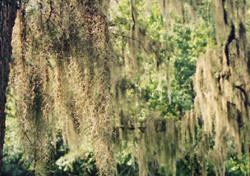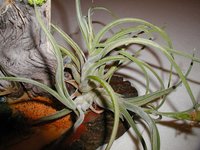Tillandsia
|
|
| Tillandsia | ||||||||||||
|---|---|---|---|---|---|---|---|---|---|---|---|---|
 Spanish Moss (Tillandsia usneoides) growing on an oak tree in SE USA | ||||||||||||
| Scientific classification | ||||||||||||
| ||||||||||||
| Species | ||||||||||||
|
About 400 species including: |
The plant genus Tillandsia, a member of the Bromeliad family Bromeliaceae, is found in the deserts, forests and mountains of Central and South America, and Mexico and the southern United States in North America. The thinner leafed varieties grow in rainy areas and the thick leafed varieties in areas more subject to drought. Nutrients are gathered from the air (dust, decaying leaves and insect matter) through structures on the leaves called trichomes. Tillandsia species are epiphytes, i.e. in nature they normally grow on other plants, without being parasitic, and they grow without soil, growing instead on trees, rocks and cliffs.
Reproduction is by offsets called "pups". A single plant could have a dozen pups which can be removed and grown alone or left to form a colony.
The genus Tillandsia was named after the Finnish physician and botanist Dr. Elias Tillandz (originally Tillander) (1640-1693).
| Contents |
Cultivation and uses
Tillandsia makes an interesting houseplant, grown indoors or in a greenhouse, needing no soil because water and food is absorbed through the leaves. The roots are used as anchors only (being without root hairs through which nutrient could be taken in). They will flower occasionally but, as a houseplant, the blooms are not usually impressive. Common names for Tillandsia include Air plant, Ball moss (T. recurvata) and Spanish moss, the latter referring to T. usneoides in particular.
Light
Place in indirect or diffused sunlight in summer (full summer sun will damage the leaves) but direct sun is acceptable in winter. If indoors, Tillandsia must be placed near a bright window (avoid a north-facing view). They prefer to be outdoors in summer.
Air
Fresh, moving air is ideal.
Tillandsia..log.800pix.jpg
Watering
For all watering, the first choice is rain water. If not available, use filtered tap water or tap water. The plants should be soaked thoroughly twice a week when not in flower; more often in a hot dry environment but do not keep the plants constantly wet, allow to dry between waterings. Additionally, the plant will enjoy being sprayed once a day in summer. In autumn and winter spray three times a week. Spraying does not replace thorough soaking with a watering can or dipping entirely in water (for approximately one hour). After soaking, excess water is shaken off to avoid rot. Plants in flower are more susceptible to rot and should not be soaked. Tillandsia cannot survive in standing water, nor being planted in earth.
Temperature
Temperature is not critical, the allowable range being from 32°C down to 10°C. They are sensitive to frost, except for the hardiest species, T. usneoides, which can tolerate night-time frosts down to about -10°C.
Feeding
Spray with Bromeliad or houseplant fertilizer, once every two weeks spring and summer and once every four weeks autumn and winter. Dilute the feed to one quarter the recommended strength.
Offsets
After flowering, the plant will grow offsets or "pups" around the mother plant. Leave these on if possible, as the plant will be heartier if left to form a colony.
Fixing plant to a base
Fix with silicone adhesive or a non-water soluble glue, on the lower leaves but try to avoid the base from which the roots grow. For a mount, try seashells, log sections, driftwood, coral, rocks, pottery, fountains or crystals. If desired, decorate the mount with sphagnum moss (dyed or natural green) and ornaments.de:Tillandsien fr:Tillandsia it:Tillandsia nl:Tillandsia

